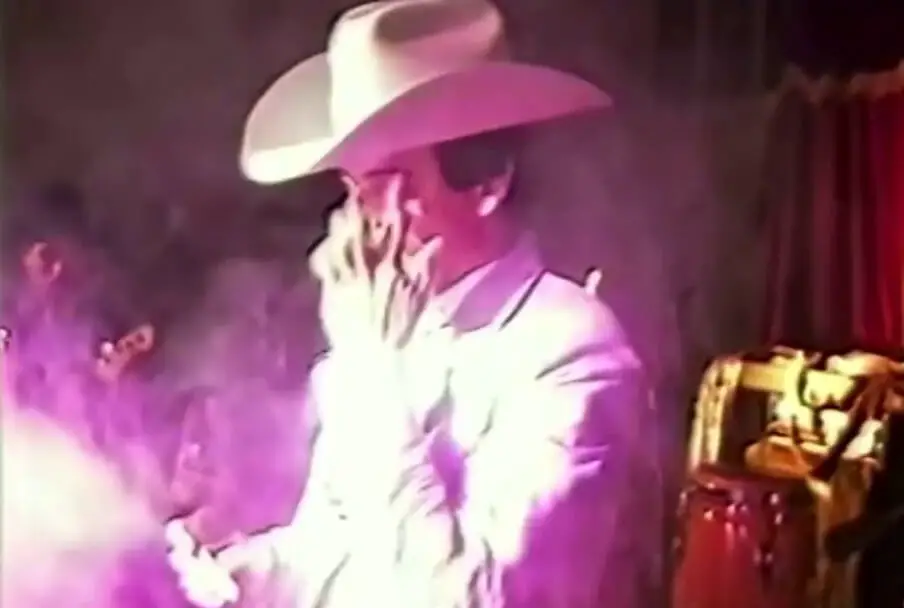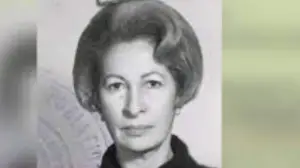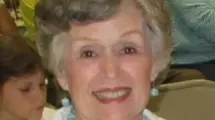Chalino Sanchez was a Mexican singer-songwriter who became famous for his narcocorridos, a genre of music that narrates the stories of drug lords, smugglers, and outlaws.
He was known for his distinctive voice, his fearless attitude, and his controversial lyrics.
He was also one of the first artists to record and distribute his music independently, selling cassettes out of his car trunk
Chalino Sanchez is widely regarded as one of the most influential figures in regional Mexican music, and his legacy lives on through his songs and his son, Adan “Chalino” Sanchez, who followed in his footsteps until his own untimely death in 2004.

Who is Chalino Sanchez?
Chalino Sanchez was born on August 30, 1960, in Las Flechas, Sinaloa, Mexico.
He was the youngest of eight siblings and grew up in a poor and violent environment.
His father died when he was six years old, and his brother was killed by a rival gang when he was 15.
Chalino avenged his brother’s death by shooting the murderer and then fled to the United States to avoid arrest.
He settled in Inglewood, California, where he worked as a dishwasher, a gardener, a cook, and a low-level drug dealer.
Chalino discovered his passion for music when he was in prison for stealing a car.
He wrote his first song, “Recordando a Armando”, as a tribute to his brother.
He also began to compose corridos for other inmates who wanted to immortalize their stories in song.
After he was released, he met Angel Parra, a local musician who helped him record his first demo tape with a norteño group called Los Cuatro de la Frontera.
Chalino started to perform at local parties and clubs, and gained popularity among the Mexican immigrant community.
He also caught the attention of Pedro Rivera, the founder of Cintas Acuario, an independent record label that specialized in narcocorridos.
Rivera offered Chalino a contract and access to a professional studio, where he recorded some of his most famous songs, such as “Nieves de Enero”, “Coquio Castro”, and “El Gallo de Sinaloa”.
Chalino Sanchez Cause of Death
Chalino Sanchez’s life was cut short on May 16, 1992, when he was murdered in Culiacán, Sinaloa, the heartland of the drug cartels that he sang about.
The night before, he had performed at a club called El Parral, where he received a note from someone in the audience that allegedly contained a death threat.
Chalino read the note calmly and continued singing “Alma Enamorada”, as if nothing had happened.
This moment was captured on video by some of his fans, and has since become known as the “death note”.
You can watch the video here.

Following the performance, Chalino departed in the company of his entourage, split between two vehicles.
Along their route, a cluster of armed individuals, purporting to be state police officers, intercepted them while driving Chevrolet Suburbans.
Demanding Chalino’s exit from his car and insisting on his presence before a commander, he consented but requested his cousin’s accompaniment as a witness.
Unyielding, the men seized Chalino forcefully and forcibly removed him.
At daybreak, two local farmers stumbled upon his lifeless body adjacent to an irrigation canal by Highway 15.
The distressing scene revealed Chalino’s fate—twice shot in the back of the head, blindfolded, wrists bearing marks of restraint, garbed in attire reminiscent of his last concert.
The rationale behind his murder remains shrouded, spawning a plethora of theories, from ties to drug trade to affiliations with the figures he sang about.
Speculations span revenge by those affronted by his music, or even allegations of political orchestrations by the government or rival factions.
Chalino’s untimely demise reverberated through the hearts of fans and musicians alike, drawing thousands to his funeral.
His music, more resonant than ever, became a vessel for commemorating his legacy and preserving his enduring impact.
Chalino Sanchez Death Note
The note that Chalino Sanchez received during his final concert has ignited extensive speculation and debate among both his dedicated fans and biographers.
The content of the note, widely believed to be a death threat intended to either end his life or deter him from performing in Culiacán, remains shrouded in uncertainty.
Despite the pervasive conjecture, the precise wording of the note has never been definitively confirmed or unveiled.
According to certain sources, the note conveyed phrases like: “You’re going to die tonight” or “You won’t leave here alive.”
Alternately, some assert that the note bore a more personalized message, such as: “You sang about my brother, and I’m set on ending your life” or “Your debt to me demands payment through your life.”
Contrary viewpoints propose that the note wasn’t menacing at all; rather, it was a plea or challenge along the lines of: “Sing me a corrido” or “Prove your courage by singing here.”
The authorship of the note also remains enigmatic.
Suggestions range from Eduardo Gallegos, the individual who had previously shot Chalino in California four months earlier and trailed him to Mexico to finish the job, to the possibility that a hired hand of a drug lord or politician with a vendetta against Chalino or his music composed it.
There is even speculation that a fan wrote it, either to gauge Chalino’s mettle or provoke a response.
This note has evolved into an emblem of Chalino’s indomitable spirit and defiance.
Regardless of its contents, he remained unfazed, discarding the note and continuing to perform with his trademark charisma and confidence.
Undaunted by fear or hesitation, he resolutely rebuffed all attempts at intimidation or censorship.
He sang unfalteringly until the culmination of his performance, seemingly aware that this was his final night.
Chalino Sanchez Death Scene
The location where Chalino Sanchez’s life came to a tragic end stands as an enduring image in the annals of Mexican music history.
In this poignant scene, the singer’s form lies supine on a dirt road, encircled by verdant vegetation and tranquil waters.
His eyes are shut, while his lips rest slightly parted.
Stains of blood grace his countenance and attire.
His visage exudes an air of tranquility and acceptance, as though he had made peace with his destiny.
This heart-wrenching discovery fell into the hands of two farmers en route to their field labor.
Along the canal’s edge, they encountered Chalino’s lifeless figure and immediately recognized the renowned crooner.
Swiftly, the authorities were notified, hastening to the site to confirm his identity.
Within his pockets lay his wallet, identification, and a modest sum of money; however, no weaponry or leads to his assailants were unearthed.
Shortly thereafter, press photographers descended upon the scene, capturing the solemn tableau.
Subsequently, these snapshots found their way into newspapers, periodicals, and the collective consciousness, evoking profound dismay and sorrow among Chalino’s dedicated admirers, struggling to reconcile the loss of their idol.
They stirred fellow artists to honor his memory through musical compositions, poems, and narratives, a testament to his profound influence.
This tableau has now melded into the fabric of Mexican heritage and lore, emblematic of the tragic demise of a young, burgeoning legend.
Concurrently, it serves as a mirror to the stark veracity of violence and corruption plaguing Mexico, especially regions such as Sinaloa, under the sway of unbridled drug cartels.
An indelible imprint, this scene continues to resonate, provoking a haunting and profound response in all who behold it.
Where did Chalino Sanchez get shot at?
Chalino Sanchez’s life was marred by two separate instances of gun violence, occurring in distinct locales: one in California and the other in Mexico.
First Incident
The initial incident unfolded on January 25, 1992, within the confines of a Coachella, California nightclub known as El Parral.
While performing on stage, Chalino fell victim to an assault by Eduardo Gallegos, a local mechanic under the influence of narcotics.
Springing onto the stage, Gallegos fired two shots into Chalino’s chest region, narrowly missing his lung.
Chalino, harboring a concealed firearm beneath his belt, retaliated by discharging at Gallegos.
This exchange of gunfire ignited a tumultuous clash between the two and their accompanying associates, resulting in injuries to multiple bystanders.
Emerging from this encounter with his life, Chalino was subsequently transported to a Palm Springs hospital for critical surgical intervention.
His convalescence saw him resiliently return to his musical vocation. Gallegos, too, survived the confrontation and was apprehended by law enforcement.
His explanation cited a lack of personal animosity motivating the attack; instead, he professed to have received payment to carry out the shooting, although the identity of the instigator and their motives remained undisclosed.
Second Incident
The second fateful occurrence transpired on May 16, 1992, near Culiacán, Sinaloa, Mexico.
Having performed at a venue dubbed El Parral the preceding evening, Chalino encountered a dire warning in the form of a threatening note.
Departing the establishment alongside his entourage, he encountered a group of purported state police officers who intercepted their journey.
Using force, the armed men seized Chalino and transported him to an undisclosed location, where they fatally shot him twice in the back of his head. Subsequently, his lifeless body was abandoned near an irrigation canal adjacent to Highway 15.
As dawn broke, two local farmers stumbled upon Chalino’s remains, and the authorities swiftly confirmed his demise at the site.
The identities of his assailants, as well as their subsequent capture, remained elusive mysteries.
https://youtu.be/pq_slGrI4gw
Conclusion
Chalino Sanchez’s life culminated tragically on May 16, 1992, found shot in Culiacán, Sinaloa.
This haunting scene, where his life was cut short, endures as a somber reminder of the violence he both sang about and encountered, symbolizing the intersection of his music with the grim reality he portrayed.
If you found the intriguing life and legacy of Chalino Sanchez captivating, check out our blog for more compelling stories.






















































